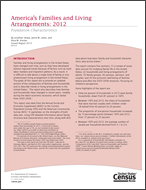
An official website of the United States government
Here’s how you know
Official websites use .gov
A .gov website belongs to an official government organization in the United States.
Secure .gov websites use HTTPS
A lock (
) or https:// means you’ve safely connected to the .gov website. Share sensitive information only on official, secure websites.
-
//
- Census.gov /
- Library /
- Publications /
- America’s Families and Living Arrangements: 2012
America’s Families and Living Arrangements: 2012
America’s Families and Living Arrangements: 2012
Introduction
Families and living arrangements in the United States have changed over time, just as they have developed distinct regional trends because of factors such as local labor markets and migration patterns. As a result, it is difficult to talk about a single kind of family or one predominant living arrangement in the United States. The goals of this report are to provide an updated picture of the composition of families and households and to describe trends in living arrangements in the United States. The report also describes how families and households have changed in recent years, notably during the latest economic recession, which lasted from 2007–2009.
This report uses data from the Annual Social and Economic Supplement (ASEC) to the Current Population Survey (CPS) and the American Community Survey (ACS). It capitalizes on the strengths of both data sets, using CPS detailed information about family structure and characteristics over time, along with ACS data about how basic family and household characteristics vary across states.
The report contains five sections: (1) a review of some data sources for studying family life in the United States; (2) households and living arrangements of adults; (3) family groups; (4) spouses, partners, and couples; and (5) the economic well-being of families before and after the 2007–2009 recession, focusing on children’s perspective.
Some highlights of the report are:
• Sixty-six percent of households in 2012 were family households, down from 81 percent in 1970.
• Between 1970 and 2012, the share of households that were married couples with children under 18 halved from 40 percent to 20 percent.
• The proportion of one-person households increased by 10 percentage points between 1970 and 2012, from 17 percent to 27 percent.
• Between 1970 and 2012, the average number of people per household declined from 3.1 to 2.6.
• Nearly three-quarters (72 percent) of men aged 65 and over lived with their spouse compared with less than half (45 percent) of women.
• Married couples made up most (63 percent) of the family groups with children under the age of 18.
• Partners in married opposite-sex couples were less likely (4 percent) to be different races than partners in either unmarried opposite-sex couples (9 percent) or same-sex couples (12 percent).
• Black children (55 percent) and Hispanic children (31 percent) were more likely to live with one parent than non-Hispanic White children (21 percent) or Asian children (13 percent).
• During the latest recession, the percentage of stay-at-home mothers declined and did not return to its prerecession level until 2012.
• During the latest recession, homeownership among households with their own children under the age of 18 fell by 15 percent. These households saw a 33 percent increase in parental unemployment.
Others in Series
Publication
Publication
Publication
Share
Some content on this site is available in several different electronic formats. Some of the files may require a plug-in or additional software to view.
 Yes
Yes
 No
NoComments or suggestions?


Top


